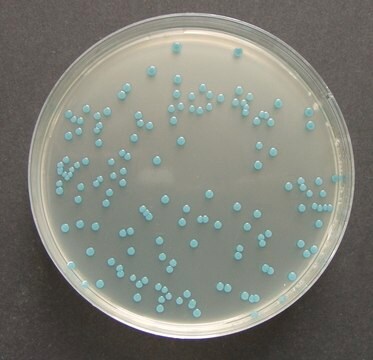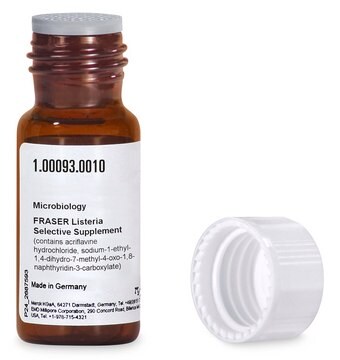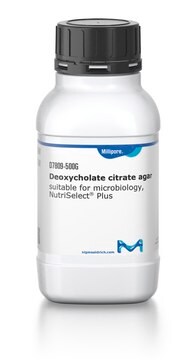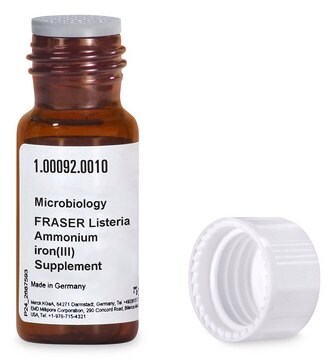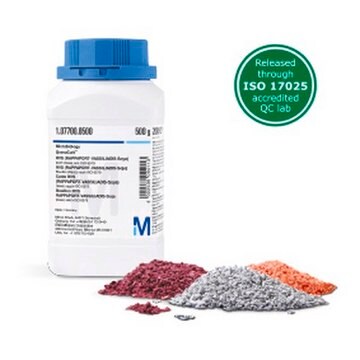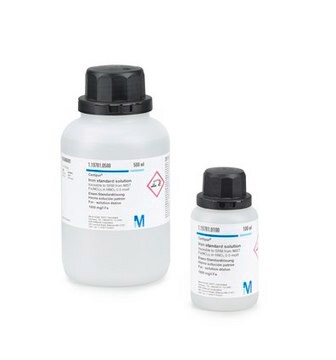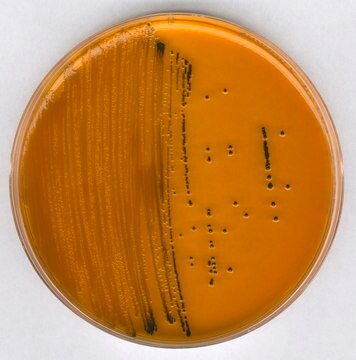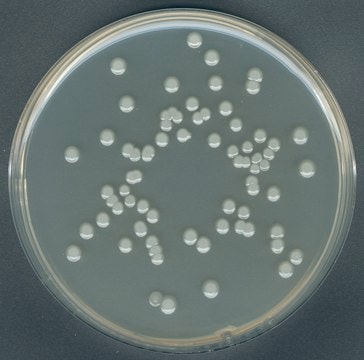1.02894
GranuCult® plus Deoxycholate lactose agar
for coliforms, suitable for microbiology
Synonym(s):
Coliform selective agar
Sign Into View Organizational & Contract Pricing
All Photos(1)
About This Item
UNSPSC Code:
41106213
NACRES:
NA.74
Recommended Products
sterility
non-sterile
Quality Level
form
granular
packaging
pkg of 500 g
manufacturer/tradename
GranuCult® plus
storage condition
dry media (Keep tightly closed)
technique(s)
microbiological culture: suitable
color
red-brown
pH
6.9-7.3 (25 °C, 57 g/L in H2O)
solubility
57 g/L
application(s)
food and beverages
microbiology
storage temp.
15-25°C
suitability
coliforms
Related Categories
General description
GranuCult® plus Deoxycholate lactose agar is a selective agar for the enumeration and isolation of Coliform bacteria from milk, water, ice cream, and other materials. The concentrations of deoxycholate and citrate are so low that the coliform bacteria can grow normally, whereas the accompanying Gram-positive bacteria are inhibited. Degradation of lactose to acid is detected by the pH indicator neutral red, which changes its color to red, and by a zone of precipitation caused by bile acid.
Application
GranuCult® plus Deoxycholate lactose agar is suitable for the enumeration and isolation of Coliform bacteria from milk, water, ice cream, and other materials.
Features and Benefits
- GranuCult® offers superior granulated culture media
- Safe and sustainable due to reduced risks associated with fine dust and toxic substance inhalation, resulting in a safer work environment
- Excellent wettability, solubility, and free-flowing properties
- Convenient, with minimal component separation and clumping, even under warm or humid conditions
- High batch-to-batch reproducibility
- Prolonged shelf life of up to five years
- High number of test strains exceeding all regulatory demands
- Granulation technology allows many supplements to be included, with no need to add these separately
Analysis Note
Appearance (clearness): clear to slightly opalescent
Appearance (colour): red-brown
pH-value (25 °C): 6.9 - 7.3
Solidification behaviour (2 hrs., 45 °C): liquid
Recovery on test medium (Escherichia coli ATCC 25922 (WDCM 00013)): ≥ 40 %
Recovery on test medium (Klebsiella pneumoniae ATCC 13883 (WDCM 00097)): ≥ 40 %
Recovery on test medium (Enterobacter cloacae ATCC 13047 (WDCM 00083)): ≥ 40 %
Recovery on test medium (Salmonella typhimurium ATCC 14028 (WDCM 00031)): ≥ 40 %
Recovery on test medium (Salmonella enteritidis ATCC 13076 (WDCM 00030)): ≥ 40 %
Recovery on test medium (Shigella flexneri ATCC 12022 (WDCM 00126)): ≥ 40 %
Recovery on test medium (Proteus mirabilis ATCC 14273): ≥ 40 %
Recovery on test medium (Enterococcus faecalis ATCC 11700): ≤ 0.01 %
Recovery on test medium (Staphylococcus aureus ATCC 25923 (WDCM 00034)): ≤ 0.01 %
Colony colour (Escherichia coli ATCC 25922 (WDCM 00013)): red
Colony colour (Klebsiella pneumoniae ATCC 13883 (WDCM 00097)): pink/red
Colony colour (Enterobacter cloacae ATCC 13047 (WDCM 00083)): pink/red
Colony colour (Salmonella typhimurium ATCC 14028 (WDCM 00031)): colourless
Colony colour (Salmonella enteritidis ATCC 13076 (WDCM 00030)): colourless
Colony colour (Shigella flexneri ATCC 12022 (WDCM 00126)): colourless
Colony colour (Proteus mirabilis ATCC 14273): colourless
Precipitate (Escherichia coli ATCC 25922 (WDCM 00013)): +
Precipitate (Klebsiella pneumoniae ATCC 13883 (WDCM 00097)): +/poor
Precipitate (Enterobacter cloacae ATCC 13047 (WDCM 00083)): +/poor
Incubation: 24 hrs.; 35 °C; aerobic.
Appearance (colour): red-brown
pH-value (25 °C): 6.9 - 7.3
Solidification behaviour (2 hrs., 45 °C): liquid
Recovery on test medium (Escherichia coli ATCC 25922 (WDCM 00013)): ≥ 40 %
Recovery on test medium (Klebsiella pneumoniae ATCC 13883 (WDCM 00097)): ≥ 40 %
Recovery on test medium (Enterobacter cloacae ATCC 13047 (WDCM 00083)): ≥ 40 %
Recovery on test medium (Salmonella typhimurium ATCC 14028 (WDCM 00031)): ≥ 40 %
Recovery on test medium (Salmonella enteritidis ATCC 13076 (WDCM 00030)): ≥ 40 %
Recovery on test medium (Shigella flexneri ATCC 12022 (WDCM 00126)): ≥ 40 %
Recovery on test medium (Proteus mirabilis ATCC 14273): ≥ 40 %
Recovery on test medium (Enterococcus faecalis ATCC 11700): ≤ 0.01 %
Recovery on test medium (Staphylococcus aureus ATCC 25923 (WDCM 00034)): ≤ 0.01 %
Colony colour (Escherichia coli ATCC 25922 (WDCM 00013)): red
Colony colour (Klebsiella pneumoniae ATCC 13883 (WDCM 00097)): pink/red
Colony colour (Enterobacter cloacae ATCC 13047 (WDCM 00083)): pink/red
Colony colour (Salmonella typhimurium ATCC 14028 (WDCM 00031)): colourless
Colony colour (Salmonella enteritidis ATCC 13076 (WDCM 00030)): colourless
Colony colour (Shigella flexneri ATCC 12022 (WDCM 00126)): colourless
Colony colour (Proteus mirabilis ATCC 14273): colourless
Precipitate (Escherichia coli ATCC 25922 (WDCM 00013)): +
Precipitate (Klebsiella pneumoniae ATCC 13883 (WDCM 00097)): +/poor
Precipitate (Enterobacter cloacae ATCC 13047 (WDCM 00083)): +/poor
Incubation: 24 hrs.; 35 °C; aerobic.
Other Notes
Appearance of Colonies & the corresponding Microorganisms
- Red, surrounded by a zone of precipitate: Lactose-positive: Escherichia coli
- Pale with a pink center and surrounded by a zone of precipitate: Weakly lactose-positive: Enterobacter, Klebsiella, and others
- Colorless: Lactose-negative: Salmonella, Shigella, Proteus, Pseudomonas, and other
Footnote
We offer two media types: the superior granulated GranuCult® and the cost-efficient powdered NutriSelect® culture media, depending on your needs.
The designations basic, plus, or prime are added to indicate the quality control level, from basic quality control to standard QC plus to prime for full regulatory compliance.
The designations basic, plus, or prime are added to indicate the quality control level, from basic quality control to standard QC plus to prime for full regulatory compliance.
Legal Information
GRANUCULT is a registered trademark of Merck KGaA, Darmstadt, Germany
NutriSelect is a registered trademark of Merck KGaA, Darmstadt, Germany
Storage Class
11 - Combustible Solids
wgk_germany
WGK 2
Certificates of Analysis (COA)
Search for Certificates of Analysis (COA) by entering the products Lot/Batch Number. Lot and Batch Numbers can be found on a product’s label following the words ‘Lot’ or ‘Batch’.
Already Own This Product?
Find documentation for the products that you have recently purchased in the Document Library.
Our team of scientists has experience in all areas of research including Life Science, Material Science, Chemical Synthesis, Chromatography, Analytical and many others.
Contact Technical Service